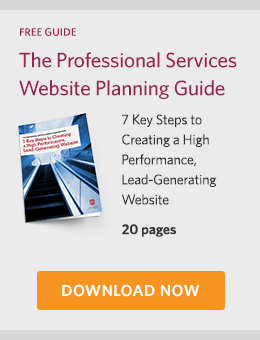Your B2B website is your most potent business development tool. It can reach and persuade more people in more markets than even the most talented sales team.
In the traditional sales and marketing model, people build relationships by interacting on a personal level, and prospects are qualified and nurtured through a series of meetings and presentations.
Today, however, certainly not all, but much of this activity happens online — often without the seller’s knowledge. More and more, B2B buyers use Google to first identify firms, and then use those firms’ websites to vet as a potential partner in business.
If your website wasn’t built with this scenario in mind, you are missing an enormous opportunity. The sooner you embrace this change — and build a website designed to generate leads and persuade prospects — the sooner you’ll benefit from today’s Internet-fueled marketplace.
What’s at Stake
Let me make one thing clear. I’m not suggesting that sales teams are irrelevant. It’s always better to have a multipronged approach to the marketplace.
But our research into professional services firms shows that the way companies find their providers is undergoing a dramatic shift.
- 80% of buyers check out a firm’s website during the buying process.
- And 30% of buyers rule out a firm because they were unimpressed by its website.
What does this mean for you?
It means that many buyers go to your website before they ever talk to you — if they find your website at all.
In today’s marketplace, then, your website needs to achieve two objectives:
- Make it easy for interested people and companies to find you.
- Persuade potential buyers that you offer what they need
A B2B Website is Easy to Find and Generates Leads
 The lead-generating B2B website is a complex organism. It consists of several specialized components, and these need to work in harmony.
The lead-generating B2B website is a complex organism. It consists of several specialized components, and these need to work in harmony.
- Free Educational Content. Writing educational content is how a firm shares its expertise with the world. Expertise is the currency of online lead generation. It’s how people find you (through search) and begin to trust you (by relying on your insight, advice and opinions). But it’s a commitment — a different approach to marketing. You’ll need to produce new pieces on a regular basis.
- A Blog. A blog is the most common way to deliver a stream of educational content. It’s the heart and soul of most content strategies. In addition, many firms create resource libraries where they make other types of content available: articles, white papers, webinar recordings, videos, etc.
- Search Engine Optimization (SEO). Your blog posts and other content won’t rank well in Google — and won’t be found online — if you don’t optimize them for keywords and perform other crucial optimization tasks. SEO is a complex topic, so you may want to hire a consultant or firm to help you.
- High-Value Pieces of Content. These are usually longer-format pieces than the content that you make freely available (such as blog posts). Examples of high-value content include e-books and executive guides. These pieces have a higher perceived value, allowing you to put them behind a registration form. Many of your web visitors will happily exchange some of their personal information for a valuable piece of content. The most important piece of information you will collect on these forms is a person’s email address. You can then use email to offer them more relevant educational materials and build a loyal following over time. This is not spam. This is content the people value and look forward to receiving.
- Offers. Offers allow you to promote those high-value pieces of content on your website. They are also a way to encourage people near the end of the sales funnel to contact you directly to set up a consultation or ask for a proposal. Think of them as advertisements that you place on relevant pages of your website to entice visitors to deepen their level of engagement with you.
- Responsive Design. Google’s algorithm is a closely held secret, but the company has revealed some of its most important ranking factors. Among these is a preference for pages that function well on mobile devices. Today, that means building your site according to the principles of responsive design. Responsive design is a web development approach that allows pages to adapt to devices of any width. For instance, elements that appear side by side on a desktop computer may stack vertically on a phone. Even text may resize on certain devices to enhance readability.
- Well-Configured Analytics. Google Analytics is free and easy to install. So use it. But you can’t stop there. A high-performance B2B website needs to capture conversions, which requires some additional, more advanced setup in Google Analytics. You also need a process in place to regularly monitor and analyze the traffic on your site so that you can make adjustments and test different offers, copy and configurations.
A More Persuasive Website
Look like a leader. The aesthetics of your website communicate a lot about your company. A website that looks like a market leader creates a critical positive first impression. If you examine the websites of the leading companies in your industry you’ll notice that most of them share a few common traits:
- Simple, clutter-free designs
- Appealing, fresh-feeling imagery
- A limited color palette
- Just looking at them makes you feel good about the company
To establish credibility right off the bat, your website must pass the initial “sniff test.”
- Deliver clear, concise messaging. Use your headlines wisely. Tell your audience what you do, who you do it for, and why you are different. (If you struggle to articulate why you’re different, check out this post.)
- Write for a lay audience. The most admired experts can describe complex topics in simple, easy-to-grasp language. You should do the same on your website. You are writing for a wider audience than you think. For instance, influencers aren’t always familiar with industry jargon. If you want to communicate your value to potential referrers you would be wise to speak in language they understand.
- Use subheads. Most people don’t read every word on web pages — they skim them. You aren’t going to change how people read, so go with the flow. To facilitate this behavior, break your text into multiple bite-sized chunks and give each one a clear, descriptive subhead. This way, visitors can get the gist of a page without having to plow through every word.
- Deploy intuitive navigation. Navigation is not the place to be clever. “Services” or “What We Do” may be boring, but they have the distinct benefit of being crystal clear. Companies are looking for reasons to rule you out. Don’t make it hard for them to find the good stuff.
Your website is the key to positioning your business development program for future growth. Take a look at your website and measure it against the characteristics I list above. If it doesn’t do all of these things (and all of them are important), it’s time to make a change. Your future is waiting.
Additional Resources:
- Our Lead Generating Website Guide details how your firm can generate qualified leads with its website.
- And our free Lead Nurturing Guide will show you how to nurture those leads through the sales cycle.
- Hinge University offers a wealth of tools and information to make your website more powerful and persuasive.
How Hinge Can Help:
Your B2B website should be one of your firm’s greatest assets. Our High Performance Website Program helps firms drive online engagement and leads through valuable content. Hinge can create the right website strategy and design to take your firm to the next level.


